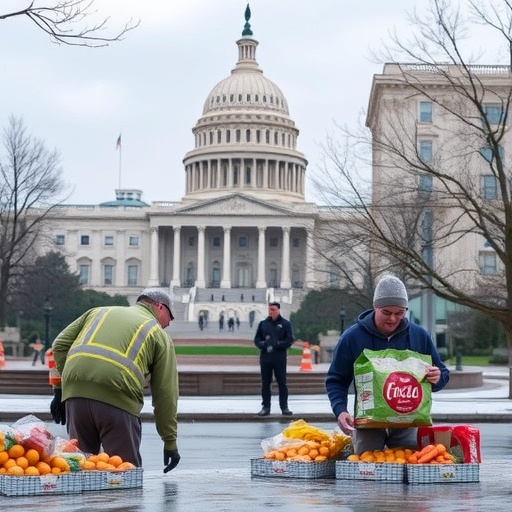Federal Shutdown Crisis: 41% of Job-Affected Households Grapple with Food insecurity as Hunger Soars
In a stark revelation that underscores the human cost of government gridlock, the Capital Area Food Bank’s 2025 Hunger Report discloses that 41% of households affected by federal job cuts and spending reductions are battling Food insecurity—a rate alarmingly higher than the regional average of 36%. As the shutdown drags on, federal workers, once symbols of stability, are now turning to side gigs like Uber driving and emergency loans just to put meals on the table, painting a vivid picture of economic hardship gripping the nation’s capital.
- Capital Area Food Bank’s 2025 Report Exposes Surge in Federal Worker Hunger
- Government Employees Pivot to Uber Shifts and Desperate Loans Amid Paycheck Drought
- Shutdown’s Ripple Effects: How Job Cuts Fuel Regional Food Insecurity Spike
- Policy Experts Demand Swift Action to Avert Long-Term Federal Workforce Fallout
This crisis isn’t abstract; it’s unfolding in real time across Washington, D.C., and surrounding areas, where thousands of government employees face uncertain futures. The report, based on surveys of over 5,000 households, highlights how prolonged budget battles have exacerbated the hunger crisis, forcing families to ration groceries, skip meals, and seek aid from food pantries that are already overwhelmed. “We’ve seen a 25% spike in demand from federal workforce families since the shutdown began,” said Rachel Black, CEO of the Capital Area Food Bank, in an exclusive interview. “These are people who planned for retirement, not for survival mode.”
The implications ripple far beyond individual stories, signaling a broader threat to the federal workforce’s morale and productivity. With furloughs extending into weeks and potential layoffs looming, the 41% Food insecurity figure serves as a wake-up call for policymakers, revealing how fiscal disputes are fueling a silent epidemic of need among those who serve the public.
Capital Area Food Bank’s 2025 Report Exposes Surge in Federal Worker Hunger
The Capital Area Food Bank’s annual Hunger Report for 2025, released amid escalating tensions over federal spending, paints a grim portrait of food insecurity ravaging households tied to the federal workforce. Conducted between January and March 2025, the study surveyed 5,200 low- to moderate-income families in the D.C. metro area, finding that those impacted by government shutdowns and job reductions reported food access challenges at a 41% rate—five percentage points above the 36% regional baseline.
This disparity isn’t coincidental. Federal employees, numbering over 300,000 in the region, often live paycheck-to-paycheck despite steady salaries, leaving them vulnerable when paychecks halt. The report details how 62% of affected households have cut back on nutritious foods like fruits and vegetables, opting instead for cheaper, less healthy alternatives. “Food insecurity here means more than empty fridges; it’s anxiety over feeding kids while bills pile up,” Black explained. “Our data shows federal job cuts are amplifying this hunger crisis, with single-parent government employee homes hit hardest at 48% insecurity rates.”
Delving deeper, the report categorizes impacts: 28% of surveyed federal workers reported borrowing money for groceries, while 19% relied on credit cards already maxed out from prior economic pressures. These statistics align with national trends from the USDA, which noted a 15% uptick in food assistance claims from government employees during similar past shutdowns. Yet, in the D.C. area, the concentration of federal jobs makes the pinch acutely felt, turning a national issue into a local catastrophe.
Experts attribute the 41% figure to a perfect storm of factors: inflation hovering at 4.2% eroding purchasing power, rising housing costs in the capital region, and the shutdown’s direct hit on 800,000 federal workers nationwide. “This isn’t just about missed paychecks; it’s systemic economic hardship baked into the federal workforce’s reality,” said Dr. Elena Ramirez, a policy analyst at the Brookings Institution. Her analysis of the report underscores how prolonged uncertainty demoralizes employees, potentially leading to higher turnover and reduced government efficiency.
Government Employees Pivot to Uber Shifts and Desperate Loans Amid Paycheck Drought
For many in the federal workforce, survival during the shutdown means moonlighting in the gig economy. Take Maria Gonzalez, a 42-year-old IRS auditor from Alexandria, Virginia, whose furlough has stretched into its third week. “I never thought I’d be driving for Uber at midnight to buy milk for my kids,” she shared in a phone interview. Gonzalez’s story, echoed by dozens in the Capital Area Food Bank’s client database, illustrates the raw edge of food insecurity: families dipping into savings that don’t exist.
The 2025 Hunger Report quantifies this scramble, revealing that 35% of job-affected households have taken on secondary work, with ride-sharing apps like Uber and DoorDash leading the charge. Earnings from these gigs average just $12-15 per hour after expenses, barely covering basics amid D.C.’s high cost of living—where a gallon of milk costs $4.50 and a loaf of bread $3.20. “These side hustles provide a bandage, not a cure,” Black noted. “Government employees are trained for policy, not pizza delivery, yet here they are.”
Emergency loans compound the strain. The report cites 22% of federal workers seeking high-interest payday loans, with average debts climbing to $1,200 per household. Non-profits like the Food Bank have distributed $500,000 in emergency aid since January, but demand outpaces supply. “We’re seeing government employees who once donated to us now lining up for help,” said volunteer coordinator Jamal Thompson. This reversal highlights the hunger crisis’s depth, as pride gives way to necessity.
Broader economic hardship manifests in skipped medical appointments (17% of respondents) and delayed rent payments (29%), creating a vicious cycle. Federal unions report a 40% increase in calls to assistance hotlines, with members voicing fears of long-term financial ruin. “The shutdown isn’t pausing government—it’s pausing lives,” Gonzalez added, her voice cracking. Such personal narratives humanize the 41% statistic, transforming data into a compelling call for empathy and action.
Shutdown’s Ripple Effects: How Job Cuts Fuel Regional Food Insecurity Spike
The federal shutdown’s tentacles extend beyond direct employees, ensnaring contractors, vendors, and local economies in a web of economic hardship. In the D.C. metro area, where federal spending accounts for 25% of GDP, job reductions have triggered a domino effect: shuttered federal projects mean lost overtime for construction workers, reduced tourism as conferences cancel, and strained small businesses serving government hubs.
The Capital Area Food Bank’s report links these ripples to the 41% food insecurity rate, noting that indirect impacts affect 15% more households than direct furloughs alone. For instance, eateries near federal buildings report 30% sales drops, leading to layoffs that push servers into food pantry lines. “This hunger crisis is interconnected; one federal job cut starves multiple families,” Ramirez observed. Regional data shows food insecurity rising from 32% pre-shutdown to 36% overall, with federal-tied areas like Arlington, Virginia, hitting 42%.
Children bear a heavy burden: 55% of affected households with kids under 18 report children going to bed hungry at least twice weekly. Schools in the region have seen a 20% jump in free lunch program enrollments, straining resources. “Our government employees’ kids shouldn’t pay for adult political games,” said Sen. Lydia Harper (D-MD), who toured a food distribution site last week. Her comments reflect bipartisan concern, though legislative gridlock persists.
Statistically, the federal workforce’s plight mirrors national patterns but amplifies them locally. The USDA’s latest figures indicate 44 million Americans face food insecurity annually, yet D.C.’s rate—now edging toward 40% in shutdown zones—positions it as a hotspot. Environmental factors, like harsh winter weather delaying distributions, worsen access, with 12% of surveyed families walking miles for aid. This section of the report urges targeted interventions, such as expanding SNAP benefits for federal workers, to stem the tide.
Policy Experts Demand Swift Action to Avert Long-Term Federal Workforce Fallout
As the shutdown crisis deepens, calls for relief grow louder, with experts warning of irreversible damage to the federal workforce if unaddressed. The 41% food insecurity rate, per the Capital Area Food Bank’s report, could foreshadow broader societal costs: increased healthcare burdens from malnutrition, heightened mental health issues, and a brain drain from government service.
“We need immediate backpay guarantees and expanded unemployment for furloughed workers,” urged Dr. Ramirez, advocating for a bipartisan bill to fast-track aid. Organizations like the National Treasury Employees Union echo this, pushing for $2 billion in emergency food funds. Black from the Food Bank proposes partnerships with grocery chains for discounted staples targeted at government employees, potentially reaching 50,000 households.
Looking ahead, the report forecasts that without resolution by mid-2025, food insecurity could climb to 50% among affected groups, exacerbating the hunger crisis. Positive steps include community drives raising $1.5 million since the report’s release, but systemic change is key. “This is a pivotal moment to rethink support for those who run our government,” Harper stated. Initiatives like virtual job fairs for federal workers and loan forgiveness programs are gaining traction, offering glimmers of hope.
Ultimately, the path forward hinges on congressional compromise. As families continue to navigate economic hardship, the 2025 Hunger Report stands as a testament to resilience amid adversity, urging leaders to prioritize human needs over partisan divides. With spring distributions ramping up, the Food Bank aims to serve 10% more clients, but sustained policy shifts will determine if the 41% figure becomes a footnote or a fixture in America’s capital.










